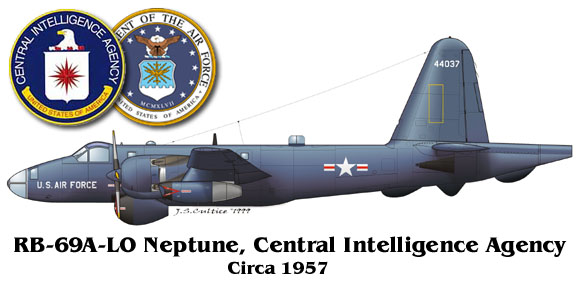|
|
 Delivered to the Central Intelligence Agency over forty-five years ago, the Lockheed RB-69A still remains a closely kept Cold War secret and a little known Skunk Works project. Under the code name PROJECT CHERRY, seven P2V-7s were pulled from the Lockheed production line, given Navy Buaer numbers and accepted by the US Air Force. The aircraft were then modified for it's new mission, most if not all ASW equipment was removed giving way to a variety of sophisticated ELINT systems. Initially flown by Air Force volunteers ultimately assigned to the CIA, they and the foreign pilots hired by the CIA, were given new identities, complete with backgrounds and rehearsed cover stories. Using the USAF as a cover and the proliferation of the Neptune in both US and international service allowed the CIA aircraft to go relatively "unnoticed". In 1956-57, after extensive training, the CIA Neptunes became operational, five aircraft going to the Republic of China (Taiwan) and two going to Wiesbaden Air Base in West Germany. The RB-69As in Germany joined a host of other aircraft gathering intelligence on the nations along the Iron Curtain. The RB-69As used for the Russian missions were often flown by Polish or Czechoslovakian crews, since they were more familiar with eastern Europe terrain and languages. The early missions were a mix of border surveillance and penetration flights into communist airspace, collecting power grid data. The RB-69As were known to have operated from primary bases in Germany, Japan, England, Turkey, Norway and Greece. The European Neptune program was eventually compromised and the Wiesbaden missions were terminated by 1963. The United States and the Republic of China had a long history of joint clandestine efforts against mainland China beginning in 1955 with project HUNTING WOLF. The Neptunes that had previously flown in Europe were sent to Taiwan where they joined those first sent during 1957 to replace the aging B-17s previously used for ELINT work. The RB-69As were loaned to the ROCAF 34th Squadron, 8th Group, operating from Hsinchu Air Base, which also served as U.S. Headquarters for the project. No markings were carried on the ROC Neptunes other than a removable placard on the vertical tail bearing a ROCAF number. Some Neptunes carried four aft-facing AIM-9B "Sidewinder" missiles on wing pylons. The 34th Squadron, nicknamed the "Bats", flew most missions at night, below 1,000 feet. In addition to the ELINT snooping and leaflet drops, the RB-69As flew night missions to drop agents by parachute. Over-flights of communist Chinese territory were routine and comparatively safer than Europe, since China had not yet established a sophisticated SAM defense network. More than 80 penetrations of Chinese airspace were flown from 1958 through the mid 1960s. Missions were also flown over North Vietnam. In time the Mainland Chinese improved their air defenses, which began to take its toll on the small group of Neptunes. From 1961 to 1964, five of the RB-69As were either lost to hostile actions by the Communist Chinese or operational accidents. The last two Neptunes were finally withdrawn from service in 1964-5 and their final disposition is currently unknown. The Profile The RB-69As were delivered in the standard sea blue finish applied to all production Neptunes at the time. The RB-69As wore standard U.S. Air Force markings on the nose and a serial number on the tail. This example is the most "famous" of the RB-69s, the subject of a series of official USAF photographs. Bibliography Lockheed P2V Neptune: An Illustrated History, Wayne Mutza, Schiffer Publishing Ltd. 1996
|